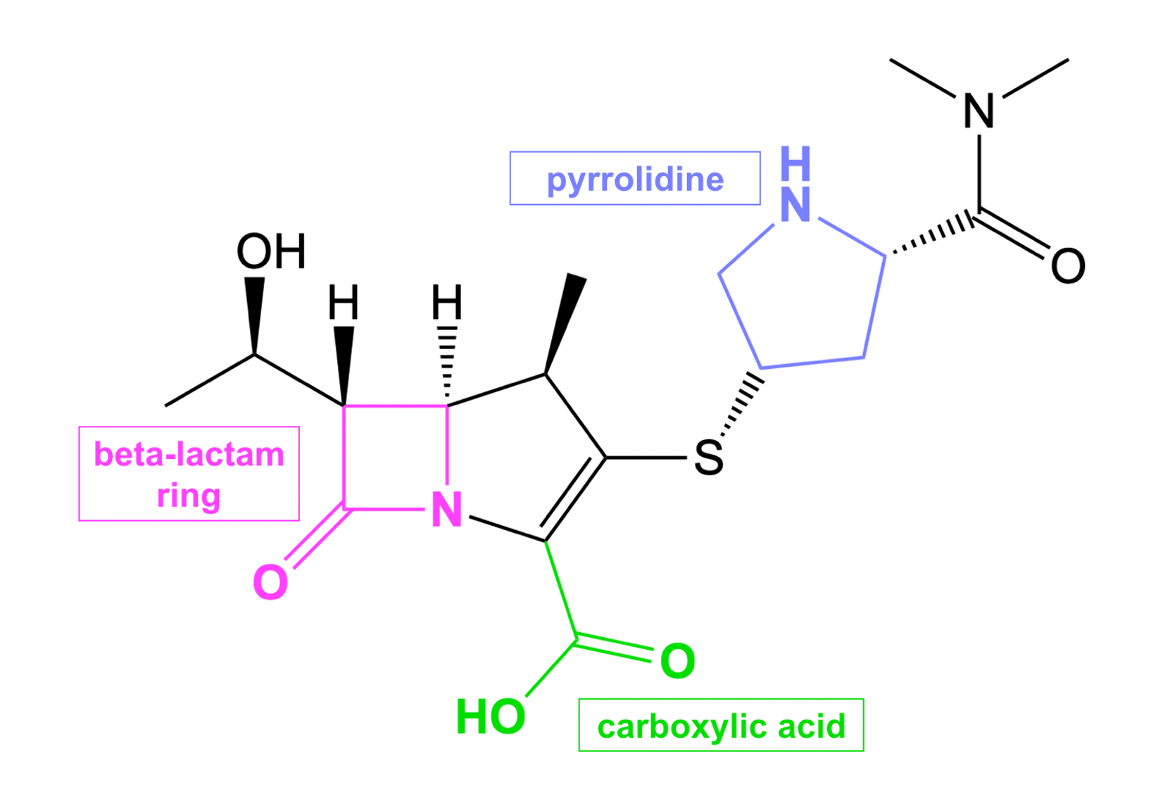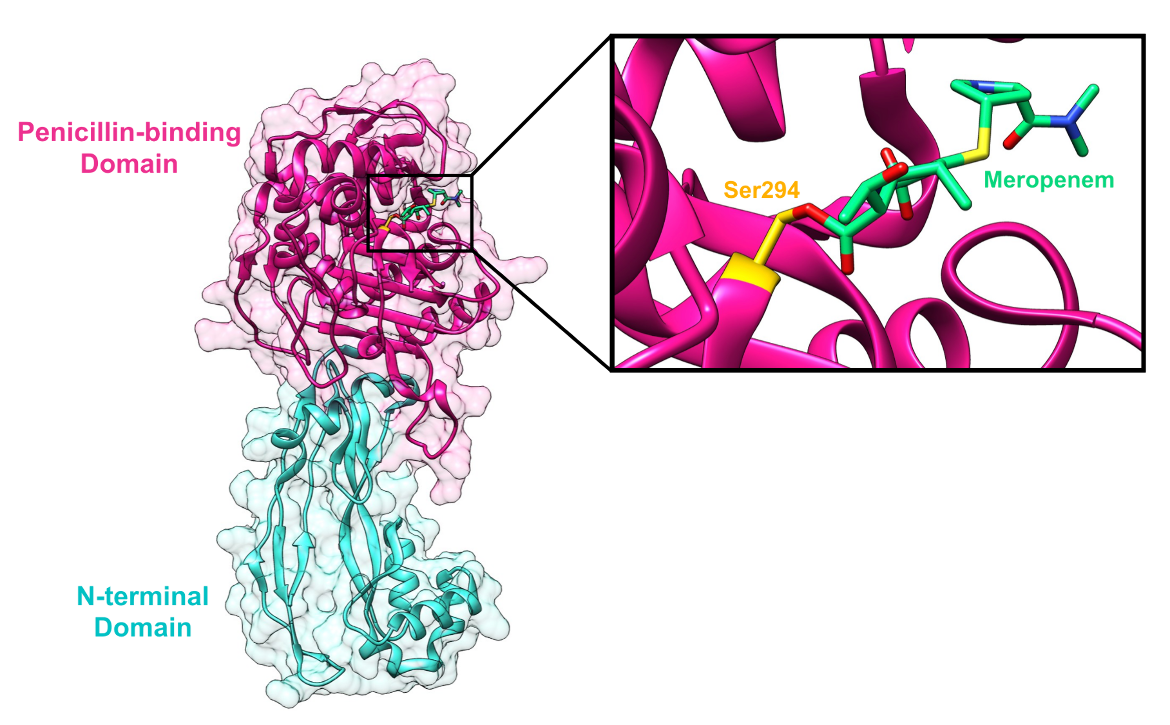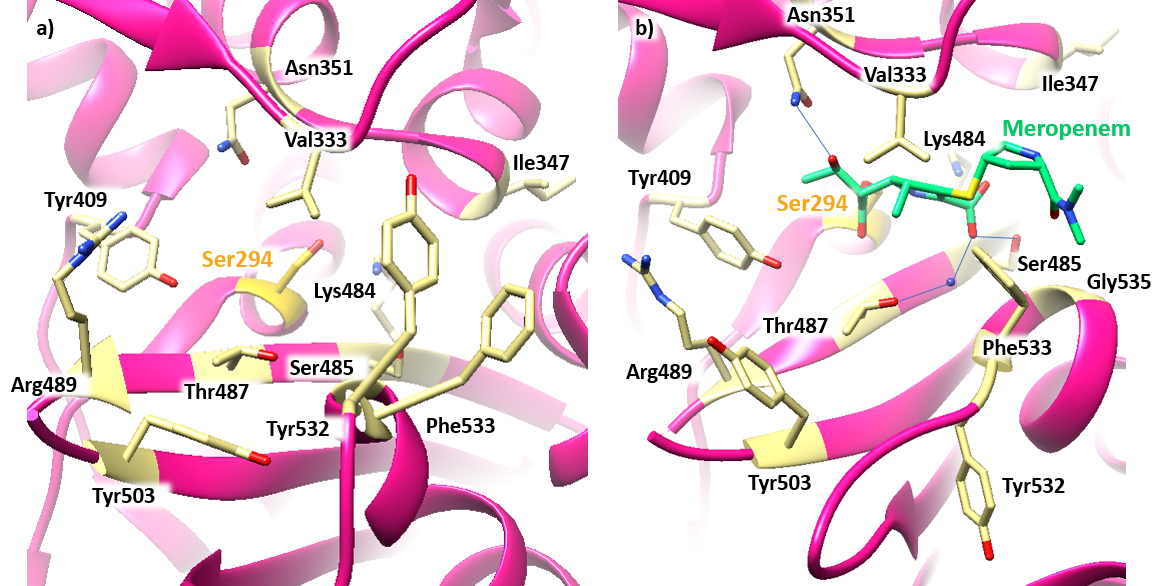Meropenem
Drug Name
Meropenem is a broad-spectrum antibiotic used against gram-positive and gram-negative bacteria. By penetrating bacterial cells readily and interfering with the synthesis of vital cell wall components, meropenem leads to bacterial death. It is often administered in combination with Varborbactam.
Table 1. Basic profile of meropenem.
| Description | Intravenously administered carbapenem broad-spectrum antibacterial drug |
| Target(s) | Penicillin-binding proteins (PBPs) |
| Generic | Meropenem |
| Commercial Name | Merrem, Vabomere |
| Combination Drug(s) | Vabormere (Meropenem + Vaborbactam) |
| Other Synonyms | Aronem, Aropen, Carbanem, Meronem, Meropen, Merotec |
| IUPAC Name | (4R,5S,6S)-3-{[(3S,5S)-5-(dimethylcarbamoyl)pyrrolidin-3-yl]sulfanyl}-6-[(1R)-1-hydroxyethyl]-4-methyl-7-oxo-1-azabicyclo[3.2.0]hept-2-ene-2-carboxylic acid |
| Ligand Code in PDB | MEM, MER (bound form) |
| PDB Structure | 3pbr (Structure of Meropenem bound to PBP3) |
| ATC code | J01DH02 |
|
|
|
Antibiotic Chemistry
Meropenem is a carbapenem antibiotic so its β-lactam ring is fused to a five-membered, unsaturated ring that contains carbon atoms. In addition, it has a few structural features that contribute to its antibacterial properties. For instance, the pyrrolidine moiety (shown in blue Figure 2) contributes to its stability in the active site and ability to inhibit normal bacterial function (Han et al., 2010).

|
| Figure 2. 2D structure of meropenem showing the functional moieties responsible for antibacterial activity. Structure created using ChemDraw. |
Drug Information
Table 2. Chemical and physical properties (DrugBank).
| Chemical Formula | C17H25N3O5S |
| Molecular Weight | 383.463 g/mol |
| Calculated Predicted Partition Coefficient: cLogP | -0.69 |
| Calculated Predicted Aqueous Solubility: cLogS | -1.8 |
| Solubility (in water) | 5.63 mg/mL |
| Predicted Topological Polar Surface Area (TPSA) | 110.18 Å2 |
Drug Target
Meropenem is a parenterally administered, broad-spectrum drug that disrupts cell wall biosynthesis in bacteria by inhibiting the penicillin-binding proteins (PBPs). This name originates from the ability of penicillin and other β-lactam antibiotics to bind to these proteins. Some of these PBP enzymes are responsible for catalyzing the final steps of the peptidoglycan synthesis pathway, which include polymerizing glycan strands and then cross-linking adjacent chains to form the characteristic mesh structure of peptidoglycan. On the other hand, other PBPs are involved in regulating peptidoglycan recycling and cell wall remodeling. Peptidoglycan, which is a polymer consisting of amino acids (peptido-) and sugars (-glycan), is the major component of the bacterial cell wall, and its mesh-like structure provides the cell wall with structure and rigidity.
Click here to learn more about PBPs.
Inhibition of the PBPs responsible for cross-linking results in a severely weakened cell wall, which then causes bacterial cell lysis and death. However, inhibition of those PBPs involved only in peptidoglycan remodeling is non-lethal to the bacteria. Meropenem has very high affinities for PBP2, PBP3, and PBP4 of Escherichia coli and Pseudomonas aeruginosa as well as PBP1, PBP2, and PBP4 of Staphylococcus aureus (DrugBank). The discussion here will specifically be focused on how the antibiotic binds to and inhibits PBP3 in P. aeruginosa.
Drug-Target Complex
The target of meropenem, PBP3 of P. aeruginosa, consists of two domains (Han et al., 2010):
1. N-terminal domain (residues 50-224)
2. Penicillin-binding domain (residues 225-579)
The active site is located in the penicillin-binding domain, where β-lactam antibiotics, such as meropenem, bind (Figure 1).
PBP3 serves as a transpeptidase during peptidoglycan synthesis in P. aeruginosa cells. This means that in the absence of meropenem, PBP3 is able to catalyze cross-linking between glycan strands to form the mesh-like structure of peptidoglycan. It is a monofunctional enzyme because it is only involved in cross-linking, or transpeptidation, not in polymerizing the nascent glycan strands, a process known as transglycosylation. The Ser294 nucleophile is where the D-Ala-D-Ala peptide bond of the peptide substrate binds in the active site and takes part in the transpeptidation reaction.
Click here to learn more about PBP3.
Meropenem is able to bind to and inhibit PBP3 due to the structural similarity it shares with the terminal D-Ala-D-Ala peptide bond of the natural substrate. Specifically, the β-lactam ring, which is characteristic of all β-lactam antibiotics, is a structural mimic of the backbone of the D-Ala-D-Ala peptide, allowing the antibiotic to occupy the same binding site as the natural substrate.
The antibiotic reacts with the Ser294 nucleophile and forms an acyl-enzyme covalent complex (Figure 1). The natural peptide substrate can no longer access the active site of PBP3 since the β-lactam blocks the Ser294 residue, which thus inactivates the enzyme and prevents transpeptidation.
Meropenem is stabilized in the active site of PBP3 of P. aeruginosa by hydrogen-bonding and hydrophobic interactions. The C3 carboxylic acid of meropenem is anchored by a water-mediated hydrogen bond with Thr487. The structure of PBP3 undergoes significant conformational changes to complex with meropenem, especially in the loop connecting β5 and α11 at the mouth of the active site. Here, the methyl group of meropenem's pyrrolidine core triggers a 180-degree flip of the Tyr532 side chain away from the active site.
Phe533 moves toward the active site to form a tunnel-like hydrophobic pillar with Val333 to stabilize the methyl group of the pyrrolidine core. The carbamoyl pyrrolidinyl group of meropenem is further stabilized by water-mediated hydrogen bonds with the Ile347 and Gly535 backbone (Han et al., 2010). The hydrophobic interactions between two residues, Tyr532 and Phe533, and meropenem, as well as water-mediated hydrogen bonds are important for PBP3 to recognize and position the drug for acylation of Ser 294.
Pharmacologic Properties and Safety
Table 3. Pharmacokinetics: ADMET of meropenem.
| Features | Comment(s) | Source |
|---|---|---|
| Oral Bioavailability (%) | N/A | N/A |
| IC50 (nM) | For P. aeruginosa it is 0.105 mg/L (for binding to PBP1a), 0.037 mg/L (for binding to PBP1b), 0.744 mg/L (for binding to PBP2, 6.034 mg/L (for binding to PBP3a), and 0.003 mg/L (for binding to PBP4) | (Siriyong et al., 2019) |
| Ki (µM) | N/A | N/A |
| Half-life (hrs) | ~ 1 hour | DrugBank |
| Duration of Action | 4-5 hours | FDA |
| Absorption Site | N/A | N/A |
| Transporter(s) | N/A | N/A |
| Metabolism | Primarily excreted unchanged. The one metabolite is microbiologically inactive. | DrugBank |
| Excretion | ~ 70% excreted unchanged by the kidneys over 12 hours | DrugBank |
| AMES Test (Carcinogenic Effect) | Non AMES toxic | DrugBank |
| hERG Safety Test (Cardiac Effect) | Weak inhibitor | DrugBank |
| Liver Toxicity | Liver injury is rare, and the cause of mild, transient serum enzyme elevations during IV meropenem therapy is unknown and rarely requires dose adjustment. Meropenem has also been linked to rare cases of cholestatic jaundice that usually arises after 1 to 3 weeks of therapy. Immunoallergic features may be present but are rarely prominent. | LiverTox |
Drug Interactions and Side Effects
Table 4. Drug interactions and side effects of meropenem.
| Features | Comment(s) | Source |
|---|---|---|
| Total Number of Drug Interactions | 29 drugs | Drugs.com |
| Major Drug Interaction(s) | bcg; buproprion; cholera vaccine; live divalproex sodium; iohexol; iopamidol; metrizamide; tramadol; typhoid vaccine, live; valproic acid | Drugs.com |
| Alcohol/Food Interaction(s) | sodium restriction diets (from congestive heart failure, hypertension, etc) | Drugs.com |
| Disease Interaction(s) | Colitis (major), Renal dysfunction (major), CNS disorders (moderate), Hemodialysis (moderate) | Drugs.com |
| On-target Side Effects | Redness and swelling at the injection site | Drugs.com |
| Off-target Side Effects | Diarrhea, rash, nausea/vomiting, injection site inflammation, thrombocytosis | Drugs.com |
| CYP Interactions | CYP450 3A4 substrate | DrugBank |
Links
Table 5: Links to resources to learn more about meropenem
| Comprehensive Antibiotic Resistance Database (CARD) | ARO: 0000073 |
| DrugBank | DB00760 |
| Drugs.com | https://www.drugs.com/mtm/meropenem.html |
| FDA | https://www.accessdata.fda.gov/drugsatfda_docs/label/2016/050706s037lbl.pdf |
| LiverTox: National Institutes of Health (NIH) | https://www.ncbi.nlm.nih.gov/books/NBK547861/ |
| PubChem CID | 441130 |
Learn about meropenem resistance.
References
Han, S., Zaniewski, R.P., Marr, E.S., Lacey, B.M., Tomaras, A.P., Evdokimov, A., Miller, J.R., Shanmugasundaram, V. (2010) Structural basis for effectiveness of siderophore-conjugated monocarbams against clinically relevant strains of Pseudomonas aeruginosa. Proc Natl Acad Sci U S A. 107, 22002-7. https://doi.org/10.1073/pnas.1013092107
Jia, B., Raphenya, A. R., Alcock, B., Waglechner, N., Guo, P., Tsang, K. K., Lago, B. A., Dave, B. M., Pereira, S., Sharma, A. N., Doshi, S., Courtot, M., Lo, R., Williams, L. E., Frye, J. G., Elsayegh, T., Sardar, D. Westman, E. L., Pawlowski, A. C., Johnson, T. A., Brinkman, F. S., Wright, G. D., McArthur, A. G. (2017) CARD 2017: expansion and model-centric curation of the Comprehensive Antibiotic Resistance Database. Nucleic Acids Research 45, D566-573. https://doi.org/10.1093/nar/gkw1004
LiverTox - Clinical and Research Information on Drug-Induced Liver Injury. National Institutes of Health. https://www.ncbi.nlm.nih.gov/books/NBK548666/
Meropenem for injection. (2016) Food and Drug Administration. https://www.accessdata.fda.gov/drugsatfda_docs/label/2016/050706s037lbl.pdf
Meropenem. PubChem. https://pubchem.ncbi.nlm.nih.gov/compound/441130
Meropenem - DrugBank. Drugbank.ca https://go.drugbank.com/drugs/DB00760
Meropenem (injection). Drugs.com https://www.drugs.com/mtm/meropenem.html
Siriyong, T., Murray, R.M., Bidgood, L.E., Young, S.A., Wright, F., Parcell, B.J., Voravuthikunchai, S.P., Coote, P.J. (2019). Dual β-lactam combination therapy for multi-drug resistant Pseudomonas aeruginosa infection: enhanced efficacy in vivo and comparison with monotherapies of penicillin-binding protein inhibition. Sci Rep. 9, 9098. https://doi.org/10.1038/s41598-019-45550-z
March 2025, Gauri Patel, Helen Gao, Shuchismita Dutta; Reviewed by Dr. Andrew Lovering
https://doi.org/10.2210/rcsb_pdb/GH/AMR/drugs/antibiotics/cellwall-biosynth/pbp/blm/meropenem






